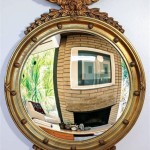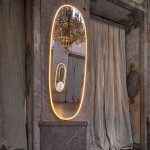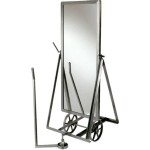Which Mirror Cannot Form a Magnified Image?
Mirrors, being reflective surfaces, are fundamental components in optics, used to manipulate the direction of light and create images. The ability of a mirror to form an image depends on its shape and the principles of reflection. While different types of mirrors can produce a variety of image characteristics, including magnification, certain mirrors are inherently incapable of forming magnified images. This article will delve into the various types of mirrors and explain why a specific type cannot produce a magnified image, clarifying the underlying physics that govern their image-forming properties.
Mirrors are generally categorized based on their reflecting surface shape. The primary categories include plane mirrors, concave mirrors, and convex mirrors. Each type possesses unique characteristics and exhibits distinct behaviors concerning image formation. Understanding these differences is crucial for determining which type is incapable of magnification.
A plane mirror, as its name suggests, has a flat reflective surface. Concave mirrors curve inward, resembling the inside of a spoon, while convex mirrors curve outward, resembling the outside of a spoon. The curvature of a mirror significantly impacts the way light rays are reflected and, consequently, the characteristics of the image formed.
Plane Mirrors and Image Formation
Plane mirrors are the most commonplace type of mirror found in everyday life. They provide a simple reflection of objects placed in front of them. However, the image formed by a plane mirror possesses specific characteristics that preclude the possibility of magnification. The image is always virtual, upright, and of the same size as the object. "Virtual" means that the image appears to be behind the mirror, formed by the apparent intersection of reflected rays, but light rays do not actually converge at that point.
The image formed by a plane mirror is also laterally inverted, meaning that the left and right sides are reversed. This is commonly perceived as a mirror image being a flipped version of the object. The key property to note is that the image size is always equal to the object size. The magnification (M) can be mathematically represented as the ratio of the image height (hi) to the object height (ho): M = hi / ho. For a plane mirror, since hi = ho, the magnification is always 1. This indicates that the image is neither enlarged nor diminished.
The inability of a plane mirror to produce a magnified image stems directly from its flat surface. Parallel rays of light incident on the mirror are reflected as parallel rays. There is no convergence or divergence of light rays that would lead to a change in the image size relative to the object size. The image appears to be located as far behind the mirror as the object is in front of it, maintaining the one-to-one size relationship.
Concave Mirrors and Image Formation
Concave mirrors, with their inward-curving reflecting surface, have the capability to form both real and virtual images, depending on the object's position. When an object is placed beyond the focal point of a concave mirror, a real, inverted image is formed. A real image is formed by the actual convergence of reflected light rays and can be projected onto a screen.
The magnification produced by a concave mirror is dependent on the object's distance from the mirror's surface. If the object is placed far away from the mirror (beyond the center of curvature), the image will be smaller than the object, resulting in a diminished image. However, as the object is brought closer to the mirror (between the center of curvature and the focal point), the image becomes larger than the object, yielding a magnified image. The extent of magnification increases as the object approaches the focal point.
When the object is placed inside the focal point of a concave mirror, a virtual, upright, and magnified image is formed. This is the principle behind magnifying mirrors used for applying makeup or shaving. The virtual image appears to be behind the mirror and is larger than the object. Therefore, concave mirrors can certainly form magnified images under specific conditions.
Convex Mirrors and Image Formation
Convex mirrors, characterized by their outward-curving reflecting surface, offer a wider field of view compared to plane or concave mirrors. However, unlike concave mirrors, convex mirrors can only form one type of image, and that image is always virtual, upright, and diminished (smaller than the object). This inherent limitation prevents convex mirrors from ever producing a magnified image.
The reason for this lies in the way light rays are reflected by a convex surface. Parallel rays of light incident on a convex mirror diverge upon reflection. These diverging rays appear to originate from a point behind the mirror, creating a virtual image. Since the reflected rays are diverging, the image formed is always smaller than the object, regardless of the object's distance from the mirror. The image appears further away and proportionally smaller to fit within the extended field of view offered by the convex shape.
Convex mirrors are commonly used as rearview mirrors in vehicles and security mirrors in stores because they provide a wide-angle view of the surroundings. The smaller image size allows for a larger area to be visible in the mirror, enhancing situational awareness. However, this advantage comes at the cost of image magnification; the images are always reduced in size.
Mathematically, the magnification for a convex mirror is always less than 1 (M < 1), indicating that the image is always smaller than the object. The image distance is always negative, further confirming its virtual nature. The focal length of a convex mirror is also considered negative, reflecting its diverging properties.
In summary, while concave mirrors can produce both magnified and diminished images depending on the object's position, and plane mirrors always produce images of the same size, convex mirrors are inherently limited to forming only virtual, upright, and diminished images. Therefore, a convex mirror cannot, under any circumstances, form a magnified image.
Can A Convex Mirror Form Magnified Image Quora
Can A Convex Mirror Form Magnified Image Quora

Can A Convex Mirror Form Magnified Image Quora

A Concave Mirror Cannot Form Virtual Image Of Real Objectvirtual Objectreal Object
Can A Convex Mirror Form Real Image Quora

Image Formation By Concave Mirrors
Can A Convex Mirror Produce Real Image When The Object Is Virtual And Vice Versa Concave If Yes How Will It Be Possible Why Quora

Image Formation By Concave Mirrors
Which Type Of Image Is Formed If The Magnification A Curved Mirror 1 Quora
Can A Convex Mirror Form Real Image Quora








